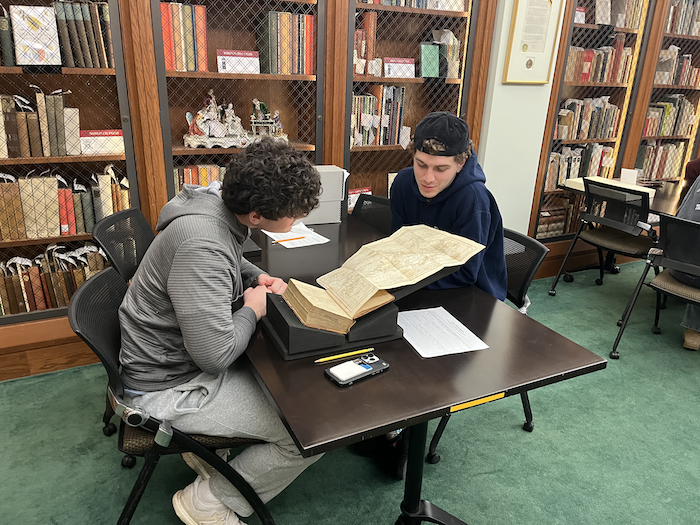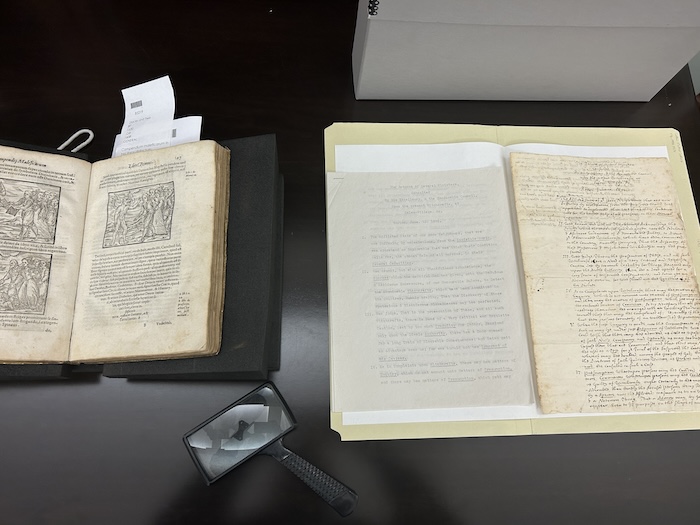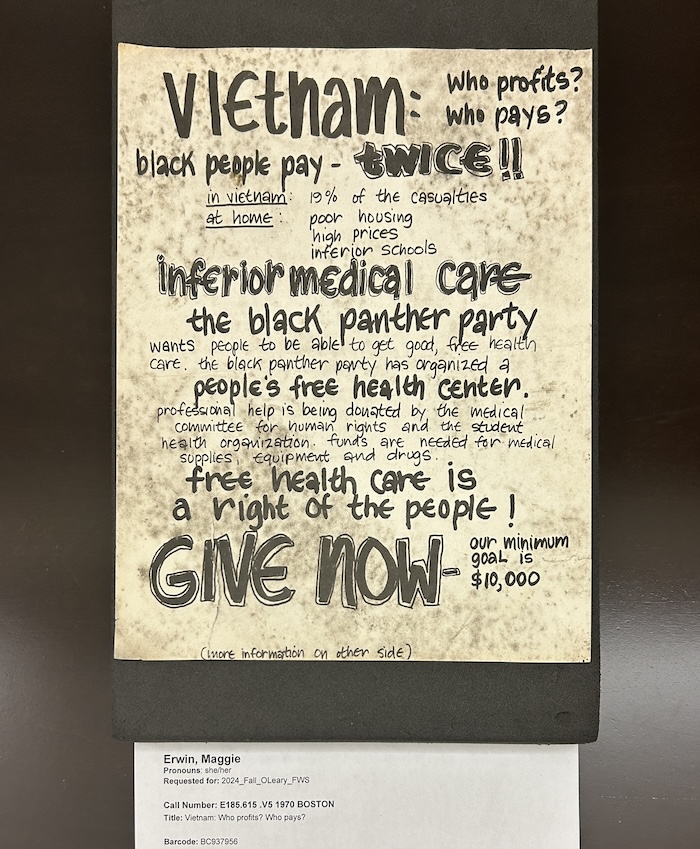“I can always come back”: Supporting Undergraduate Experiences in Special Collections with the Burns Library First-Year Writing Pilot Program
This past year, Burns Library hosted a new instruction initiative for First-Year Writing classes. 2024–2025 Outreach & Instruction Fellow Maggie Erwin shares some reflections on this pilot program. This post, written by Maggie Erwin, 2024–2025 Outreach & Instruction Fellow, was originally published on the John J. Burns Library blog on May 12, 2025.
Beginning last fall, Burns Library hosted a new instruction initiative for first-year writing classes. Collaborating with the First-Year Writing seminar program (FWS) and O’Neill librarians, the Burns FWS Pilot Program welcomed first-year undergraduate students to Burns Library and encouraged hands-on engagement with rare books and archives. The program’s goal is to provide students with the knowledge and skills necessary to explore a wide variety of rare materials, better preparing them for primary source research and emphasizing the impactful role Burns can play in their undergraduate career.
When first-year writing students entered Fine Print this year, they encountered collection materials spanning the 14th century to the present day. The selection included medieval manuscripts, witchcraft manuals, papyrus samples, binding tools, a case of type, protest pamphlets, artists’ books, broadsides, woodblocks, and archival materials from Boston-area communities. As one student reflected, “It was amazing to take a step into the past and revisit history all the way back to the 1400s.” The instruction session guided students through the history of the book in all its forms, emphasizing the diverse ways in which students can approach special collections and archives, and empowering them to pursue their own writing and research projects.

After a brief overview, students were each given a close-looking guide and encouraged to explore the materials. This exploration was grounded in the hands-on: feeling the hair versus flesh side of a manuscript, setting type in the composing stick, or tracing the raised surfaces of a woodblock. One student reflected that “…getting a hands-on experience led me to enjoy and better understand the materials” and another noted that “the tangible materials provide new insights about usage or manufacture you wouldn’t otherwise see.”

The program and materials were designed by an interlibrary team of Amanda Ferrara, Senior Instruction & Public Services Archivist at Burns Library, Sarah Rebecca Gaglio, Associate Instructional Services Librarian at O’Neill Library, and Maggie Erwin, Graduate Fellow at Burns Library. Working together to develop worksheets, assessments, lesson plans, and workflows, the FWS team offered faculty a streamlined menu of learning modules designed to build continuity across library instruction sessions. Module 1, Introduction to Special Collections & Archives, was a broad introduction intended to get students excited about special collections and archives by showcasing a diverse array of materials from international makers, regions, time periods, languages, and more. Also offered digitally to two classes, Module 1 was linked to Canvas course pages with digitized versions of a Book of Hours, the Cotton Mather Letters, Norfolk Prison Colony records, and woodblock prints from the Japanese Prints Collection. In Module 2, Introduction to Primary Source Analysis, students learned and practiced the basics of analyzing primary sources, critically evaluating the historical record, and summarizing and communicating interpretations. This module used materials curated by staff based on the theme Travel and Migration.
The materials were arranged somewhat thematically based on different ‘eras’ of book and archival history, but the students’ paths embraced a nonlinear perspective. How do the material constraints felt in handmade paper samples inform the shape and design of early-printed books? In what ways do present day broadsides and zines respond to early-modern pamphlets? The session encouraged students to think about the relationship between different historical places and communities, uncovering the ways material objects tell stories about their makers. Students remarked that the session allowed them to “see history,” and many asked questions about who used the objects and what their lives entailed. This connection between past and present was evident in one student’s reflection: “I loved being able to look at and handle artifacts dating back to the 1300s. It was really cool to think that a person from so long ago touched this and now so am I.” Teaching the history of the book with a diverse group of materials shows students that history is always in progress, and that they can make and shape the historical record with their own collections, labor, and art.


Most importantly, the FWS visits to Burns Library supported curiosity and comfort in special collections. It may not be possible to cover 500 years of book history in a 50-minute session, but it is possible to empower students with the tools and awareness necessary to pursue that history, or different histories, themselves. When asked after their visit how they could use special collections for a project, one student reflected “I could honestly pick anything from Burns and have plenty to write about for a project. Everything I saw today was so rich in history, any of them would make a powerful piece of evidence.” There are so many opportunities for undergraduate engagement in special collections beyond a mandatory class visit, but in many places barriers to entry remain. Several students noted in their post-assessments that they were nervous to touch materials and surprised by their access to rare books and archives. One student wrote that they were “nervous since I thought we wouldn’t be able to touch anything” but that the opportunity to be hands-on “made the experience better.” By emphasizing that these collections exist to be explored, we can build a stronger relationship between special collections and archives and our students. When asked what they learned in the session, a student thoughtfully wrote “that I can always come back.”

During the 2024–2025 academic year, 22 FWS classes visited Burns Library, totaling around 350 students, or about 15% of the first-year class. Next year, we will continue our collaboration to build on what students are learning about research and source analysis using hands-on engagement with primary sources. We want to strengthen existing connections first-year students are making in class and create a space where they feel comfortable and confident engaging with rare materials. As one student responded when asked what they learned: “That this is a resource available and it isn’t actually super scary.”